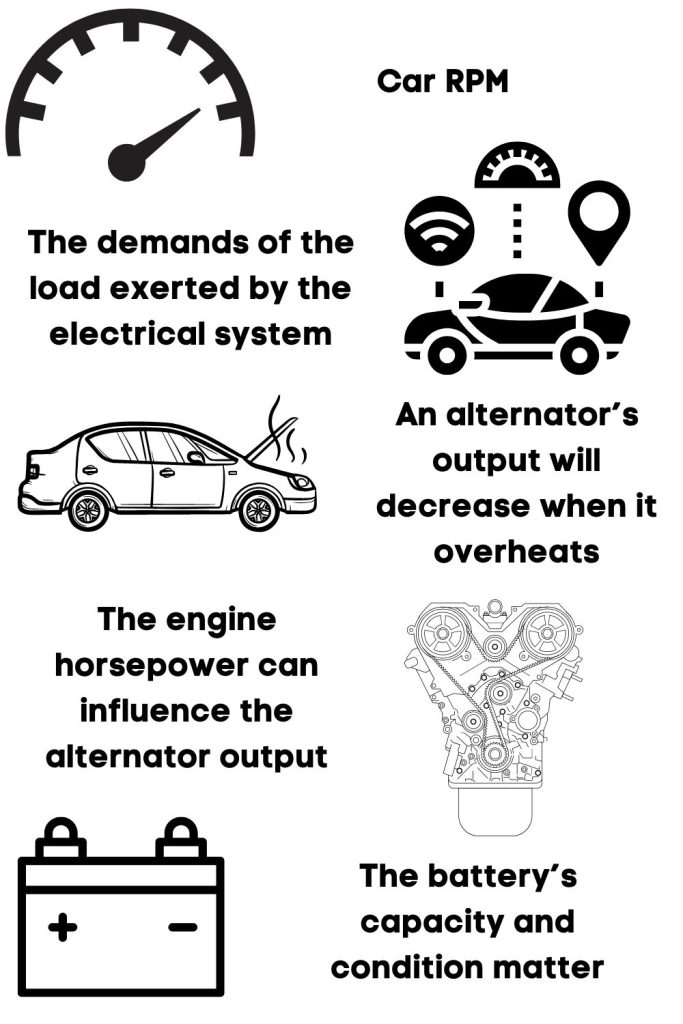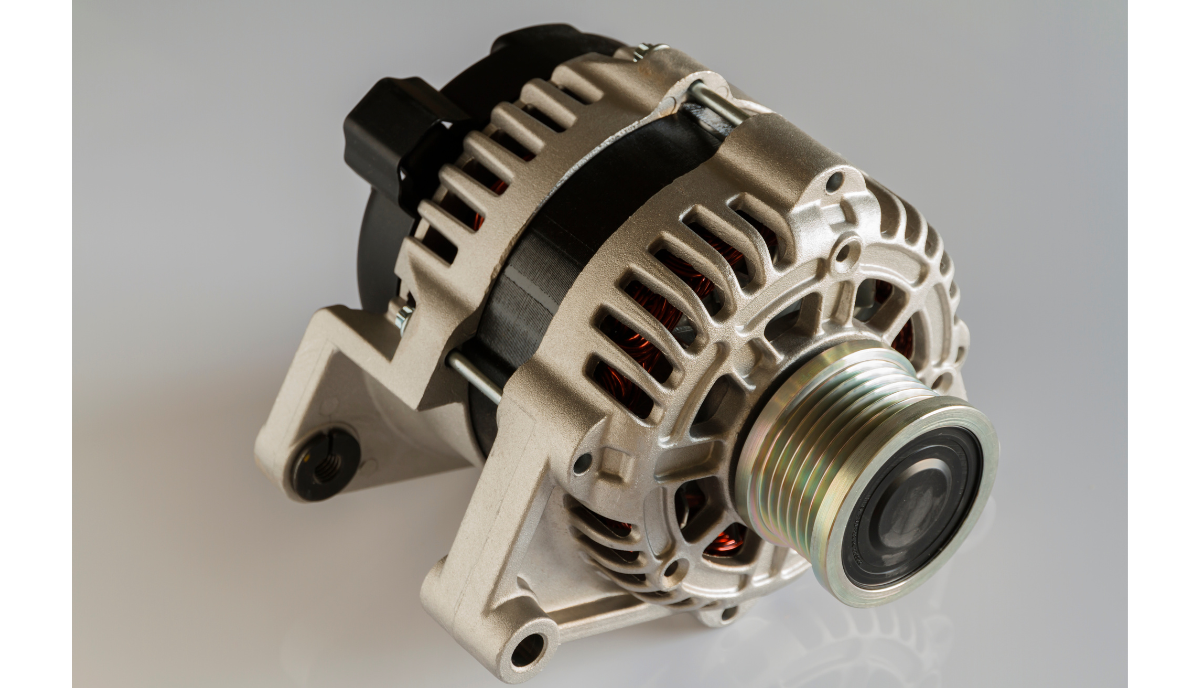The alternator turns the engine’s mechanical energy into electrical energy that powers the vehicle’s electronics. You can’t drive a car without an alternator. Yes, you can get by without the radio, air conditioner, and all the other electronic components. But eventually, the battery will discharge entirely without an alternator to recharge it. Once that happens, the car won’t start. But that raises a question. How much power should you expect the alternator to generate? This is what you should know:
1). What Is The Alternator Voltage?
The alternator voltage is between 13.5V – 15V. You expect the alternator’s voltage to exceed the battery’s voltage because it must overcome the battery’s resistance to charge it. Keep in mind that voltage is the equivalent of the pressure that forces the water through a pipe.
A higher alternator voltage increases the charging rate. A lower voltage produces the opposite result. That being said, you don’t want the alternator to overwhelm the battery. Technically, the battery shouldn’t exceed 14.5 volts.
This is why the voltage regulator matters. As the name suggests, it regulates the alternator’s voltage. When it fails, the alternator will overcharge the battery. The consequences include the following:
- The battery will overheat.
- You will notice a smell of rotten eggs coming from the battery.
- The filaments in the headlights will burn out faster than expected.
- The battery will swell.
2). What Is The Alternator Amperage?
The car alternator’s amperage is between 40 to 120 amps. You may find ratings as high as 160A, 320A, and 430A for large vehicles, such as trucks and buses.
Manufacturers base the amp rating on the RPM. For instance, for the vehicle at idle speed (1,500RPM), the output amperage will be 50A. The output amperage will increase to 120A for the rated test speed (6,000RPM).
The amperage at the rated test speed is the alternator’s typical output. The manual will also mention the voltage.
3). Do The Electrical Demands Of The Electronics And Accessories Influence The Amperage?
Yes, the electrical demands of electronics and accessories influence the amperage.. This Car Generator Inc video proves as much.
The technician in the video connected a DC amp clamp meter to their vehicle.
Initially, the meter recorded 24 amps at idle speed, with all the accessories and electronics deactivated. But then the technician turned the headlights, cabin fan, heated seats, defroster wires, and more on.
In response, the readings on the meter rose until the vehicle’s electrical draw reached 130 amps. In other words, the load shapes the alternator’s output. It will only produce the current the car requires at any given moment.
4). Why Do You Need To Know The Alternator Amperage?
- On the one hand, this information allows your vehicle to perform optimally. If you replace an old alternator with a weaker version, the car’s electronics may refuse to run. For instance, the headlights may become dim.
- On the other hand, high-output alternators are a waste of money. For instance, if an old vehicle requires 50A, a 300A alternator is unnecessary unless you want to connect high-drain accessories.
5). Can An Alternator Run A House?
An automotive alternator runs small appliances. That includes TVs and lights. You may require an inverter to produce AC power from the alternator’s output. Otherwise, this device is ill-equipped to act as a generator. Keep in mind that the electrical system in modern homes is 200 amps. The 40 to 120 amps an alternator produces are insufficient. Then again, as was noted earlier, some alternators can produce as many as 430 amps.
Factors That Affect The Power Output Of A Car Alternator
Don’t expect the alternator’s output to remain consistent at all times. The component’s power may fluctuate because of the following:

- This MATEC Web of Conferences paper has noticed that an alternator’s output increases with the RPM. In fact, the speed must exceed 2000RPM for an alternator to produce enough power to charge the battery. This is why manufacturers specify the amps an alternator can generate at a particular RPM. The amp rating doesn’t exist in a vacuum.
- The demands of the load exerted by the electrical system will also influence the power output. The higher the demand, the greater the output.
- Alternators generate heat. Autoshop101 has pictures showing the heat sinks these devices use to stay cool. An alternator’s output will decrease when it overheats. Balmar DC Charging Solutions have published a chart that shows an alternator’s output at different temperatures.
- The engine horsepower can influence the alternator output. Quick Start has given the example of a 100A alternator that needs 4HP to generate its full output.
- The battery’s capacity and condition matter. For instance, an alternator’s voltage output can fall because of a dead battery cell. According to Underhood Service, one bad cell in a battery can damage the alternator because it must work harder to maintain the rated charging voltage. If this situation persists, the alternator is more likely to overcharge the battery’s healthy cells. Don’t be surprised if the battery overheats.
Don’t ignore the alternator’s health. Defective alternators tend to deliver a lower output than their healthier counterparts. Signs of a bad alternator include a dead battery (because the faulty alternator can’t recharge it), dim headlights, and burning wires.
Relationship Between Engine Speed And Alternator Power Output
- An alternator’s power output depends on the input shaft’s rotational seed.
- The alternator speed must exceed 2000RPM before it generates a significant charging voltage. You won’t get the alternator’s maximum output until the speed reaches 6000RPM. This is why many manufacturers rate the alternator output at 6,000 RPM.
- However, the speed can reach 12,000 RPM without continuing to raise the alternator’s power output.
- The engine speed and alternator speed go hand in hand. The engine’s speed determines the alternator’s speed. The speed ratio between these two components is 1:1 for racing cars. Those figures change to 1:2 for a drag car and 1:3 for a street vehicle.
- For the average car, the alternator turns at three times the speed of the crankshaft.
Real-World Examples Of Alternator Power Output In Popular Car Models
| Toyota Hilux | 80A – 150A |
| Toyota Corolla | 115A |
| Toyota Rav 4 | 100A – 150A |
| Ford F 150 | 250A |
| Honda CR-V | 200A – 320A |
| Hyundai Tucson | 140A – 250A |
It is worth noting that alternator outputs can change with the year of the car. Additionally, you can replace a low-output alternator with a high-output alternative. Most alternators are 65A to 100A. 100 amps are more than enough to accommodate every accessory in the average vehicle.
But you can add a high-output alternator to your car if you install a high-drain accessory. That includes high-end stereos. Use an ammeter to measure your vehicle’s total electrical load. The alternator’s output should exceed the car’s electrical draw by at least 50 percent.
Otherwise, you will overwhelm the alternator and strain the battery. Talk to a mechanic before buying a new alternator. They can make a recommendation based on your vehicle’s specs.

